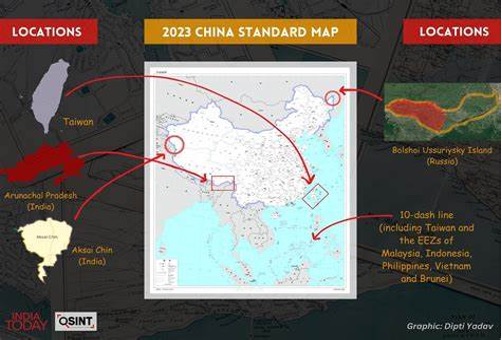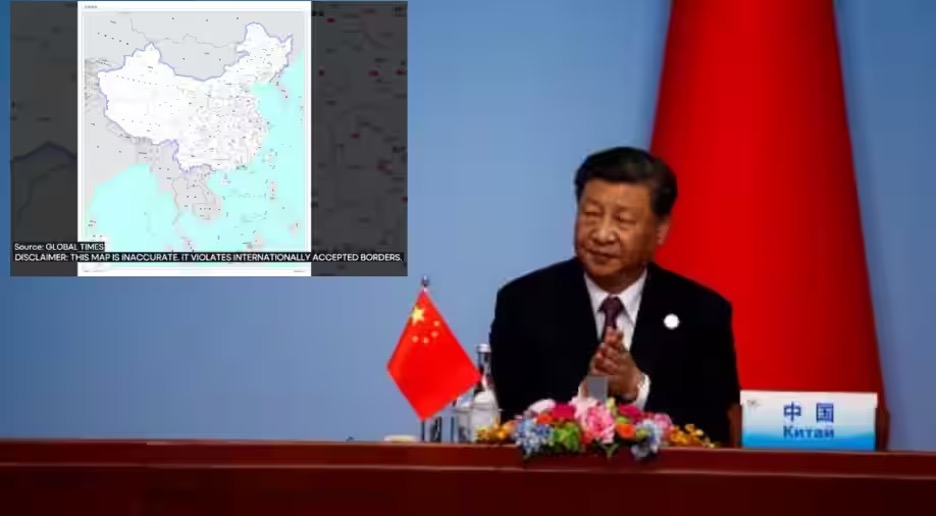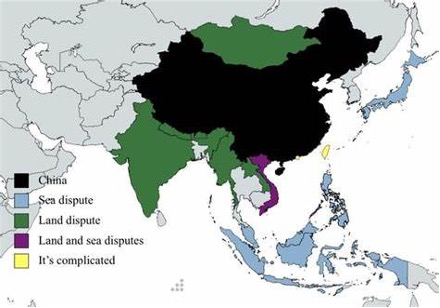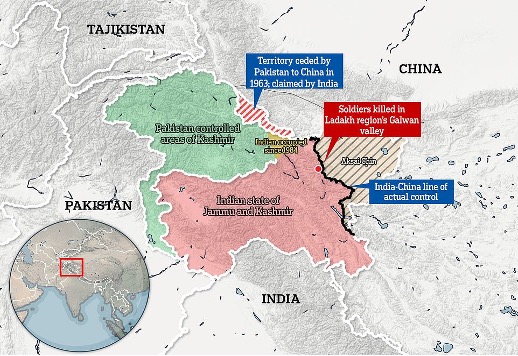The introduction of a new official map by China has provoked indignation and diplomatic disputes, since it claims territory belonging to numerous countries, including India and Russia. This move has piqued the interest of international observers, who are concerned about the implications for regional stability and global politics. It has heightened tensions in already sensitive areas, like the South China Sea. The world community is closely monitoring the situation as countries such as India, Taiwan, Vietnam, Malaysia, and the Philippines deny these claims. This article delves into the specifics of China’s new map, its territorial claims, and the reactions of impacted countries.
China’s territorial claims have long been a source of conflict between the country and its neighbours. China has asserted its sovereignty over contested territories by a variety of ways, including historical claims, strategic military bases, and diplomatic manoeuvres from the South China Sea to areas bordering India and Bhutan. The newly redesigned map now visualises these claims, reinforcing China’s position on territorial integrity.

The Ministry of Natural Resources of China recently updated its “Standard Map of China,” which has sparked significant criticism for its vast territorial claims. The map includes disputed regions such as India’s Ladakh and Arunachal Pradesh, the South China Sea, and even parts of Russia. China proclaims its sovereignty over practically the entire South China Sea by displaying the infamous nine-dash line, ignoring conflicting claims from neighbouring countries. China’s new map exacerbates these problems by increasing its claimed area and installing vital military stations on disputed islands, allowing it to establish a firmer footprint in the region. This confrontational posture threatens freedom of navigation and international law principles, drawing the ire of other countries.
Understanding why China has updated its maps is critical to determining their geopolitical consequences. The Chinese government frequently utilises territorial claims to boost domestic nationalism and legitimise themselves. These map updates reflect China’s intention to enhance its influence in the region and emphasise its place as a global superpower. Many of the disputed areas are rich in natural resources, making control of them economically beneficial. China aspires to solidify its position as Asia’s main power, challenging the influence of the US and other regional players.
China’s new map has sparked strong concerns and protests from countries whose lands China claims. India, which has been at the forefront of these charges has categorically refuted China’s bogus claims. The Indian External Affairs Ministry has officially protested. S. Jaishankar, External Affairs Minister, criticised China’s move, saying that “Making absurd claims does not make other people’s territories yours.” This verbal encounter demonstrates the underlying animosity between the two countries as well as the sensitivity surrounding territorial issues.
Vietnam, the Philippines, Malaysia, and Taiwan have all expressed their opposition to China’s sweeping claims in the South China Sea. They contend that these claims undermine national sovereignty and breach the UN Convention on the Law of the Sea. The Philippines; in particular, cited a 2016 decision by a Hague-based arbitration tribunal that invalidated China’s claim to the majority of the South China Sea.

Taiwan continues to be a highly contentious topic in China’s territorial claims. Beijing regards Taiwan as part of its territory, although Taiwan runs as an independent, self-governing country. The new maps reaffirm China’s sovereignty claims over Taiwan, causing worry on the island as well as among its allies, particularly the United States.
Despite being a close partner of China, Russia has yet to reply to the map and its implications for the two countries’ disputed territory.
China’s claims to Ladakh, Arunachal Pradesh, and other contested territories stem from its ancient claim to Tibet. As Tibet is considered part of China’s territory, any territorial claims made by Tibet extend to these regions as well, according to China. China claims Ladakh is in western Tibet whereas Arunachal Pradesh is in southern Tibet.
The assumption of Chinese authority over these areas is not a new development. China has persistently claimed these regions throughout the years, ignoring the protests of the countries involved. The international community, including India strongly opposes these claims, emphasising that these territories are an intrinsic part of their respective countries.
The publishing of contentious maps by China, as well as its repeated claims over contested territory are not unique events. The country has a history of using similar techniques, notably in relation to India. China forcibly renamed several Indian places, including mountain peaks and rivers earlier this year, prompting political confrontations.
Wang Wenbin, a spokesperson for China’s Foreign Ministry, defended the publication of the new map, claiming that exercising sovereignty in accordance with the law is regular for China. He asked India to avoid over-interpreting the map and to remain objective and calm. China’s response suggests that they see the map as a legitimate depiction of their territorial claims and dismiss India’s objections.
It is worth noting that China has taken issue with India’s map, specifically the inclusion of the recently constituted Union Territory of Ladakh. Despite India’s claim that it does not change its external borders, China vehemently opposed India’s map in 2019. This episode underscores the sensitivity of map-related issues, as well as their potential to aggravate relations between the two countries.
China’s forceful behaviour can be ascribed to its perception of India as a competitor, as it strives to constrict India’s strategic alliances with the US, its allies, and other democracies. China aspires to dethrone the United States as the world’s dominant power, while India’s growth as a regional power complicates this goal. As a result, China attempts to assert its dominance and compel India to accommodate its ambitions while limiting India’s strategic partnerships

South Asia’s altering power dynamics have piqued the interest of extra-regional powers, particularly China and the United States. The strategic importance of the region stems from its function as a gateway to the resource-rich Central Asian Republics and as a new centre of gravity. Recognising its importance, China is attempting to bring countries in the region under its influence through projects such as the Belt and Road Initiative.
However, with aspirations for regional power status, India stays cautious and attempts to maintain equidistance from China and other regional powers. India’s wait-and-see strategy allows it to assess the unfolding situation and respond appropriately, protecting its national interests.
The India-China map conflict is not a new issue. Both countries have been at odds over their geographical boundaries for decades. The Indian state of Arunachal Pradesh, which China claims as part of its own territory, is one of the primary flashpoints. With its strategic importance, the region has been a major source of strife.
Aksai Chin, a region in the disputed state of Jammu and Kashmir, is another point of contention. This region is currently administered by China which India regards to be an integral part of its territory. Conflicting claims to Aksai Chin have heightened tensions, resulting in a brief war between India and China in 1962. Furthermore, the map indicates specific Russian areas, calling into question the limits agreed upon by both governments in a 2005 agreement.
The role of India in guaranteeing security in the South China Sea is critical for the preservation of a stable maritime order in the Indo-Pacific region. Approximately, 55% of India’s trade with the Indo-Pacific region transits these waterways, highlighting their economic and strategic significance. India promotes a rules-based system in the Indo-Pacific region, adhering to the principles of the United Nations Convention on the Law of the Sea.
Given the increasing struggle for strategic influence in the Indian Ocean, India continues to strengthen its alliances with the US, Southeast Asian governments, and other regional countries. This approach tempers Chinese belligerence and presents India as a trustworthy security provider, in line with US expectations.
China’s contentious new map which claims lands belonging to other countries, has heightened tensions in areas such as the South China Sea. These claims have been severely rejected by the international community which includes countries such as India, Taiwan, Vietnam, the Philippines, and Malaysia. China’s repeated territorial aggression and incentives to restrain rivals emphasise the necessity for continuous attention and strategic collaborations among affected nations.

The world community has been closely monitoring these events. Among others, the United States, Japan, Australia, and the European Union have expressed their solidarity with the affected countries and asked China to de-escalate tensions and participate in constructive discourse. The UN has also been asked to mediate the conflicts and ensure that international law is followed.
China’s new maps mark a fundamental shift in global geopolitics. The amendments raise worries about regional stability, international law compliance, and the possibility of military conflict. The international community must maintain diplomatic efforts to resolve these concerns and secure a peaceful resolution of territorial conflicts. Furthermore, continuing discussion and transparency are required to avert future escalation and foster regional stability. The region’s security is dependent on upholding a rules-based system and respecting the sovereignty of all nations involved. The world will be looking intently to see how China’s map modifications impact the geopolitical scene in the coming years.
Written by – Kashvi
Edited by – Kushi Mayur
